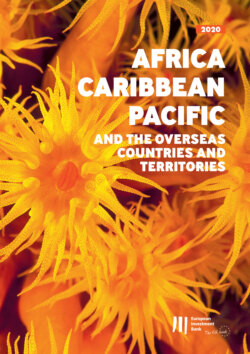Читать книгу EIB Activity in Africa, the Caribbean, the Pacific, and the Overseas Countries and Territories - Группа авторов - Страница 7
На сайте Литреса книга снята с продажи.
HUNDREDS OF PROJECTS AND BILLIONS INVESTED FOR BETTER LIVES
ОглавлениеLooking back over the story of our activities in sub-Saharan Africa, the Caribbean and the Pacific in the era of the Cotonou Mandate (see here for more information), I see intensive evolution. Since the ACP Investment Facility started operating in 2003, the Bank has financed 440 projects across 58 countries and ten regions. We have invested some €15.3 billion, of which €8.7 billion comes from the ACP Investment Facility revolving fund, and €6.6 billion from the Bank’s own resources. We had already been active in these regions since 1963, but with the Investment Facility, the Bank was ready to do much more.
The goal has been to use long-term financing to reduce poverty and help integrate ACP countries into the world economy. The pillars on which this is built are private sector development, vital infrastructure, regional integration and climate action. The Investment Facility met these goals and priorities successfully. It would have been impossible to achieve if we did not work with many partners and peers, follow the guidance of other European institutions and, crucially, adapt to the needs of people.
Our work in 2020 is a good example of how we work together to help everyone. The Bank and the European Union joined forces under the Team Europe banner to fight the COVID-19 crisis and the economic downturn at the same time, inside and outside Europe. But this is not the only example. In the past, it was common to think of us as an investment bank that provided loans to countries and regions to install water pipes and power lines. These are things that we still do, but we have expanded over the years to meet new needs and development priorities. Global initiatives such as the United Nations Sustainable Development Goals have provided the Bank and other financial institutions with a new direction. The EU Consensus on Development, inspired by the Sustainable Development Goals, has similarly given us a wider focus to work with more partners and finance more projects.
The Impact Financing Envelope has had a huge influence on our operations. Since its launch as a dedicated window of the Investment Facility in 2014, it has enabled the Bank to take on more risk and help more projects. Using Africa as an example, millions of people still have no electricity in their homes and businesses. Installing power lines and electricity infrastructure across the whole continent would be a herculean and costly challenge. That is not possible. So we are supporting a wide range of energy solutions. In areas that are beyond the reach of power lines, we are backing off-grid ideas, like the inexpensive home solar kits that have taken off around the world. The Bank has been able to provide financing for these types of projects through direct operations and investment funds alike, thereby bringing other investors on board. By filling a financing gap, we are also able to fill an energy gap. That is down to the Impact Financing Envelope.
The same goes for supporting startups and small businesses in Africa, the Caribbean and the Pacific. There has always been a clear need for financing here, but there has not always been an appetite for investing on the part of banks and other financial institutions. Venture capital is growing quickly, particularly in Africa, while we are also in the midst of a youth-driven wave of great ideas that tackle many local and regional problems. It is imperative that these entrepreneurs get financing and good advice. This makes sure ideas get off the drawing boards to help everyone in society. The Bank is in the fortunate position to be able to support companies from their inception, while they grow, and when they reach maturity. Boost Africa and the SheInvest initiative are good examples of this. Through these programmes, the Bank is able to place a premium on supporting both the young founders of the next generation of digital companies in Africa and female entrepreneurs.
Maria Shaw-Barragan visiting the EIB-financed Lake Turkana wind farm
We cannot lose sight of the fact that climate change is the overarching issue facing the world today. Its effects are being felt everywhere, and most seriously in the ACP countries. The coming decade is crucial if we are to avoid the most catastrophic consequences. Under our Climate Bank Roadmap for 2021 to 2025, we have pledged to increase the share of projects for climate change mitigation and adaptation to 50% of overall lending. We are also ensuring that our activities are Paris-aligned and that we consider the climate in everything we do.
The Bank has moved with the times. The Cotonou Mandate has enabled us to keep putting our financing to work where it is most needed. By creating the Impact Financing Envelope, we have reached more great projects, despite the higher risks. By making it a revolving fund under the ACP Migration Package, we were able to extend it to meet more investment needs. Also under the Migration Package, we were able to use the Investment Facility capacity to support more public sector projects.
Together with the European Commission and EU Member States, we have boosted economies, reduced poverty and improved millions of lives, and we have done this together in constant dialogue through the Investment Facility Committee. We are looking forward to the next chapters of stronger cooperation in Africa, the Caribbean and the Pacific. We will meet new challenges and help more people succeed.
Maria Shaw-Barragan, director of the Global Partners Department at the European Investment Bank, is responsible for lending in sub-Saharan Africa, the Caribbean, the Pacific, Asia and Latin America.
The EIB supports the 2X Challenge, which aims to show the benefits of investing in female entrepreneurs and the economic empowerment of women.
